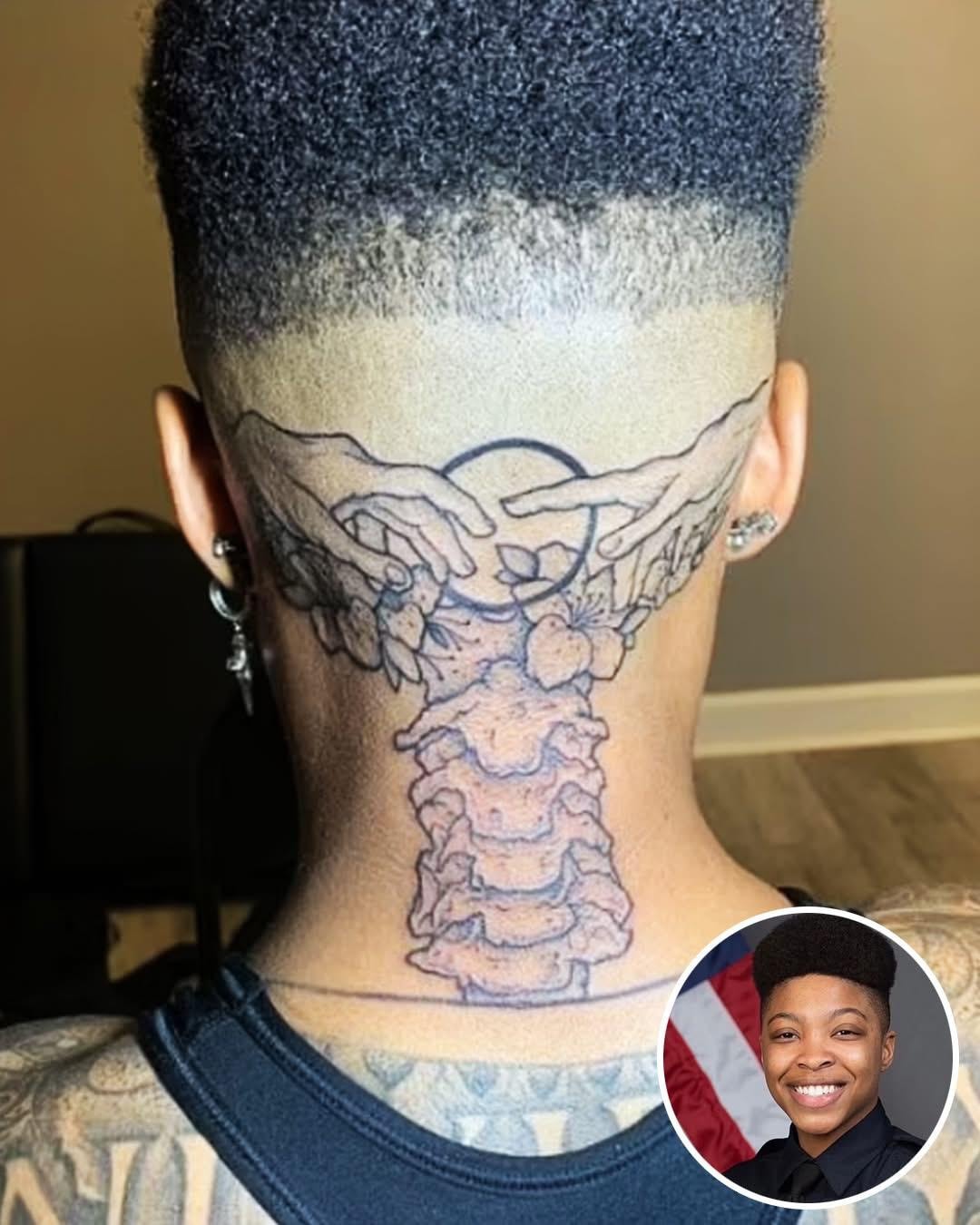The Meaning Behind Her Tattoo
For Kay’Ana, her tattoo was more than just ink; it carried a deep, personal meaning. Diagnosed with scoliosis, she saw the tattoo as a symbol of resilience and perseverance.
“My tattoos are an extension of who I am as a person,” she explained. “I got the tattoo to tell myself and others that you can still achieve certain goals regardless of the obstacles in front of you.” – said Kay’Ana Adams who got fired for a tattoo.
Scoliosis is a condition where the spine curves abnormally, often leading to physical challenges. Despite her diagnosis, Kay’Ana became a firefighter, a testament to her determination and strength.
Was the Tattoo the Real Reason?
Kay’Ana believes her termination was not solely about the tattoo. She had previously raised concerns about workplace issues, including sexist comments and inappropriate behavior during training sessions. In one instance, she called out colleagues for joking about tying nooses, a comment she found deeply offensive.
Her outspoken nature may have made her a target, leading to escalating tensions with the department. Two supportive captains, Jason Craig and Rodrick Shoots, faced repercussions for standing by her. Craig was suspended for 30 days, and Shoots was fired for allegedly obstructing orders.
Battiste claimed the actions against the captains were due to insubordination and policy violations. However, the timing raised questions about whether the department was addressing legitimate concerns or retaliating against employees who challenged its practices.

What Does Kay’Ana’s Story Teach Us?
Kay’Ana’s experience sheds light on the ongoing tension between individuality and workplace conformity. Her case raises important questions: Should workplaces adapt to embrace diversity and personal expression, or should traditional standards take precedence?
Her story is a reminder that workplace policies should strike a balance between professionalism and inclusivity. It challenges us to think critically about how rules and biases impact individuals, especially those who dare to stand out.
What are your thoughts? Is it time for workplaces to evolve and embrace individuality, or should tradition and uniformity remain the standard?
Please SHARE this article with your family and friends on Facebook.
Bored Daddy
The Meaning Behind Her Tattoo
For Kay’Ana, her tattoo was more than just ink; it carried a deep, personal meaning. Diagnosed with scoliosis, she saw the tattoo as a symbol of resilience and perseverance.
“My tattoos are an extension of who I am as a person,” she explained. “I got the tattoo to tell myself and others that you can still achieve certain goals regardless of the obstacles in front of you.” – said Kay’Ana Adams who got fired for a tattoo.
Scoliosis is a condition where the spine curves abnormally, often leading to physical challenges. Despite her diagnosis, Kay’Ana became a firefighter, a testament to her determination and strength.
Was the Tattoo the Real Reason?
Kay’Ana believes her termination was not solely about the tattoo. She had previously raised concerns about workplace issues, including sexist comments and inappropriate behavior during training sessions. In one instance, she called out colleagues for joking about tying nooses, a comment she found deeply offensive.
Her outspoken nature may have made her a target, leading to escalating tensions with the department. Two supportive captains, Jason Craig and Rodrick Shoots, faced repercussions for standing by her. Craig was suspended for 30 days, and Shoots was fired for allegedly obstructing orders.
Battiste claimed the actions against the captains were due to insubordination and policy violations. However, the timing raised questions about whether the department was addressing legitimate concerns or retaliating against employees who challenged its practices.

What Does Kay’Ana’s Story Teach Us?
Kay’Ana’s experience sheds light on the ongoing tension between individuality and workplace conformity. Her case raises important questions: Should workplaces adapt to embrace diversity and personal expression, or should traditional standards take precedence?
Her story is a reminder that workplace policies should strike a balance between professionalism and inclusivity. It challenges us to think critically about how rules and biases impact individuals, especially those who dare to stand out.
What are your thoughts? Is it time for workplaces to evolve and embrace individuality, or should tradition and uniformity remain the standard?
Please SHARE this article with your family and friends on Facebook.
Bored Daddy
The Meaning Behind Her Tattoo
For Kay’Ana, her tattoo was more than just ink; it carried a deep, personal meaning. Diagnosed with scoliosis, she saw the tattoo as a symbol of resilience and perseverance.
“My tattoos are an extension of who I am as a person,” she explained. “I got the tattoo to tell myself and others that you can still achieve certain goals regardless of the obstacles in front of you.” – said Kay’Ana Adams who got fired for a tattoo.
Scoliosis is a condition where the spine curves abnormally, often leading to physical challenges. Despite her diagnosis, Kay’Ana became a firefighter, a testament to her determination and strength.
Was the Tattoo the Real Reason?
Kay’Ana believes her termination was not solely about the tattoo. She had previously raised concerns about workplace issues, including sexist comments and inappropriate behavior during training sessions. In one instance, she called out colleagues for joking about tying nooses, a comment she found deeply offensive.
Her outspoken nature may have made her a target, leading to escalating tensions with the department. Two supportive captains, Jason Craig and Rodrick Shoots, faced repercussions for standing by her. Craig was suspended for 30 days, and Shoots was fired for allegedly obstructing orders.
Battiste claimed the actions against the captains were due to insubordination and policy violations. However, the timing raised questions about whether the department was addressing legitimate concerns or retaliating against employees who challenged its practices.

What Does Kay’Ana’s Story Teach Us?
Kay’Ana’s experience sheds light on the ongoing tension between individuality and workplace conformity. Her case raises important questions: Should workplaces adapt to embrace diversity and personal expression, or should traditional standards take precedence?
Her story is a reminder that workplace policies should strike a balance between professionalism and inclusivity. It challenges us to think critically about how rules and biases impact individuals, especially those who dare to stand out.
What are your thoughts? Is it time for workplaces to evolve and embrace individuality, or should tradition and uniformity remain the standard?
Please SHARE this article with your family and friends on Facebook.
Bored Daddy
The Meaning Behind Her Tattoo
For Kay’Ana, her tattoo was more than just ink; it carried a deep, personal meaning. Diagnosed with scoliosis, she saw the tattoo as a symbol of resilience and perseverance.
“My tattoos are an extension of who I am as a person,” she explained. “I got the tattoo to tell myself and others that you can still achieve certain goals regardless of the obstacles in front of you.” – said Kay’Ana Adams who got fired for a tattoo.
Scoliosis is a condition where the spine curves abnormally, often leading to physical challenges. Despite her diagnosis, Kay’Ana became a firefighter, a testament to her determination and strength.
Was the Tattoo the Real Reason?
Kay’Ana believes her termination was not solely about the tattoo. She had previously raised concerns about workplace issues, including sexist comments and inappropriate behavior during training sessions. In one instance, she called out colleagues for joking about tying nooses, a comment she found deeply offensive.
Her outspoken nature may have made her a target, leading to escalating tensions with the department. Two supportive captains, Jason Craig and Rodrick Shoots, faced repercussions for standing by her. Craig was suspended for 30 days, and Shoots was fired for allegedly obstructing orders.
Battiste claimed the actions against the captains were due to insubordination and policy violations. However, the timing raised questions about whether the department was addressing legitimate concerns or retaliating against employees who challenged its practices.

What Does Kay’Ana’s Story Teach Us?
Kay’Ana’s experience sheds light on the ongoing tension between individuality and workplace conformity. Her case raises important questions: Should workplaces adapt to embrace diversity and personal expression, or should traditional standards take precedence?
Her story is a reminder that workplace policies should strike a balance between professionalism and inclusivity. It challenges us to think critically about how rules and biases impact individuals, especially those who dare to stand out.
What are your thoughts? Is it time for workplaces to evolve and embrace individuality, or should tradition and uniformity remain the standard?
Please SHARE this article with your family and friends on Facebook.
Bored Daddy

